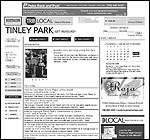On a recent Thursday my weekly local newspaper arrived in the mail. Eager to see what was happening in town I flipped to page 5 (leaving the real estate ads on pages 2, 3 and 4 behind) and found a regional story about traffic in and around the county and a feature on a school district that serves a part of the town I live in, although not my neighborhood. My kids attend a different school, and there were no stories about their school in this edition.
On page 6 the columnist was solving a problem for someone who lives 45 miles from where I do, and page 7 had a slew of short tidbits, one or two pertaining to my life but none I read for very long. The last real news page offered a profile of a business leader from a neighboring town. Press releases, entertainment news from a wide swath of northern Illinois, a large (by today’s standards) classified section, and a fluffy grip and grin section consumed the rest of the pages. For me, the “local” section of my local paper turned out to be the sports section, since school teams play each other.
I used to edit this newspaper, and when I did I oversaw the work of three local reporters each dedicated to a specific town and a county reporter responsible for regional coverage. There was also an education reporter and a reporter who did light features. A lot has changed in a few years. The county reporter is now responsible for two large counties, essentially most of northern Illinois and any breaking news. There are now two reporters responsible for the three towns and, since the education reporter and feature writer positions were cut, the two remaining reporters must contribute stories to fill those sections as well.
That Thursday my local newspaper didn’t live up to its billing. I didn’t get much news that meant much to me. But I wasn’t surprised, since I know how the staff cuts there have decimated what was already a tiny newsroom with limited resources. This local newspaper is part of a huge newspaper conglomerate that owns a downtown daily, three suburban chains, and another suburban daily newspaper. All of what was really local had been sapped out of this paper a long time ago, and advertisers noticed.
This kind of spiraling decline is happening now at a lot of corporate-owned local papers. A key question large news organizations confront is whether they can reverse the course of decline in these community papers. After all, the corporate owners are not part of the local community, nor is their approach designed to do what it takes to really deliver the kind of news and information families like mine want to read.
Local Goes Online
In April 2007, the Chicago Tribune launched TribLocal.com, a hyperlocal Web site designed to give readers the depth and breadth of news and information that their local newspapers don’t deliver. Instead of sending reporters to school board and city council meetings or having them monitor the crime beat or track politicians, new hyperlocal sites, like ours, rely on people who live in these communities to report a significant amount of the news.
Citizen journalism, as it’s called, isn’t really journalism. Instead it resembles what you’d hear in small town barbershop conversations. It’s stories about you, your neighbors, your friends, sometimes your town leaders, and what’s happening in your life and in the place you call home.
News organizations can’t afford to deploy a cadre of reporters to let residents know about fundraisers, school plays, church ice cream socials, or youth football games. Community calendars—a staple of every local paper—are fine, but they don’t tell you about what will be happening or report back once the event is over. And even if resources existed for this kind of reporting, most journalists consider this coverage beneath them. So residents send words and photographs, even video clips, to our Web site, and soon a genuine flavor of the local scene emerges.
In the fall TribLocal served a total of nine communities, each with its own Web site. A cluster of four communities is in the south suburbs of Chicago; the other is in the far western suburbs. The southern towns—bonded by shared high school districts—are bedroom communities built along a commuter rail system linking them to Chicago. The Fox River is the link for the five western towns, all of which have transitioned from mill towns into tourist destinations.
Technology enables what gets sent to TribLocal to flow directly into a publishing system built on templates. Seven staff members of TribLocal are able to do the work that in a less automated setting would require 15, maybe more. Our four “reporters” also work as editors, photographers, designers and ambassadors. As managing editor, I help to layout pages, edit stories, and direct Web site-to-publication workflow. There are two—one for each cluster—sales reps whose only job is to sell TribLocal to potential local advertisers.
Back to Newspapers
In August of this year, TribLocal.com, in a case of reverse publishing, launched two weekly newspapers, one for residents of each cluster. Content comes solely from what has already been published on the Web sites. Each week, reporters choose which stories will be considered for publication in the paper, and then the usual debate and decision-making, familiar to any newsroom, occurs. Once a story is selected, it must go through the same fact checking and editing process that any staff reporter’s work would receive.
While our online site is a free-flowing forum of ideas, with its graphic images and opinions governed, if at all, by liberal rules, the newspapers are a different animal. All the rules of publishing the Chicago Tribune apply. This means that opinions are labeled as such; language that is okay on the Web is edited for print, and situations that might lead to charges of libel, along with other legal concerns, need to be addressed.
When we first started to reverse publish this online content, the majority of stories to fill our 16 to 20 pages (with a 50-50 split between stories and advertisements) were selected from work done by our small staff of reporters.
Newspaper sales were surprisingly strong for our new product, and we found that publication of the paper drove up the page views on the Web sites significantly. This meant that more contributions from residents soon followed. When the school year got underway, local schools began to post stories. So did parents with children in youth sports, who sent photographs and game summaries. Village officials also started to use our site to get notices out to residents. And as we expected, public relations professionals and politicians also found the site useful and now post regularly. We treat their pieces as we would any other.
Reporting on Local Issues
As contributions to our site increase, the reporters’ need to “fill pages” is decreasing, and they can begin to report on issues that are crucial to the community. They also give voice to stories that come to us but need a more professional touch. There are stories to be told that only a reporter with great sources will know about, but now we often hear from someone in the community who is willing to become a reliable source—or write the story themselves. For example, residents fearful of overdevelopment and encroachment of surrounding communities incorporated into the small town of Homer Glen about five years ago. Recently, TribLocal has posted several items written by residents who are unhappy with decisions made by elected officials. We’ve also run information sent to us by residents about the sudden resignation of Homer Glen’s city manager.
We know, however, there is more to be told about this story. A community that fought so hard to come together is now splitting apart. Why is this happening? What are the issues? Can the community find a way to resolve their internal differences? These stories take time to report, and for this reason they are the type of story seldom being done by local news outlets today. A city manager’s departure will be on the front page one week and then, with little follow-up, the story will die away due to the lack of reporting resources needed to make the effort. In this case, this Homer Glen story is one we will pursue with the help of our local contributors.
What does the future hold? Early success with TribLocal.com has accelerated expansion plans for 2008 and 2009. Already more than 1,500 people have registered with us, a necessary step to post information and comments on the site. Page views have increased by double digits every month, and more local advertisers are signing up for multiple week ad runs. There are local newspapers serving the towns that TribLocal is now a part of. And they are suffering declining circulation and ad revenues, and the usual business decisions are being employed. Staffs are being cut, mastheads are being consolidated and, as a consequence, local coverage is suffering. Instead of being more relevant to their local audience, they are becoming less so.
What TribLocal—and other hyperlocal sites, some attached to newspapers, others on their own—is attempting to do is to reconnect with an audience that traditional newsgathering organizations have lost touch with. Time will tell what works and what doesn’t. During the next few years we’ll start to see how a renewed and intense focus on all things local will influence how journalism is practiced. Stay tuned.
Kyle Leonard is managing editor at TribLocal.com, the Chicago Tribune’s online hyperlocal Web site. Before assuming this position, he was managing editor, assistant bureau chief, and niche publishing manager at the Pioneer Press Newspapers in Chicago’s suburbs.
On page 6 the columnist was solving a problem for someone who lives 45 miles from where I do, and page 7 had a slew of short tidbits, one or two pertaining to my life but none I read for very long. The last real news page offered a profile of a business leader from a neighboring town. Press releases, entertainment news from a wide swath of northern Illinois, a large (by today’s standards) classified section, and a fluffy grip and grin section consumed the rest of the pages. For me, the “local” section of my local paper turned out to be the sports section, since school teams play each other.
I used to edit this newspaper, and when I did I oversaw the work of three local reporters each dedicated to a specific town and a county reporter responsible for regional coverage. There was also an education reporter and a reporter who did light features. A lot has changed in a few years. The county reporter is now responsible for two large counties, essentially most of northern Illinois and any breaking news. There are now two reporters responsible for the three towns and, since the education reporter and feature writer positions were cut, the two remaining reporters must contribute stories to fill those sections as well.
That Thursday my local newspaper didn’t live up to its billing. I didn’t get much news that meant much to me. But I wasn’t surprised, since I know how the staff cuts there have decimated what was already a tiny newsroom with limited resources. This local newspaper is part of a huge newspaper conglomerate that owns a downtown daily, three suburban chains, and another suburban daily newspaper. All of what was really local had been sapped out of this paper a long time ago, and advertisers noticed.
This kind of spiraling decline is happening now at a lot of corporate-owned local papers. A key question large news organizations confront is whether they can reverse the course of decline in these community papers. After all, the corporate owners are not part of the local community, nor is their approach designed to do what it takes to really deliver the kind of news and information families like mine want to read.
Local Goes Online
In April 2007, the Chicago Tribune launched TribLocal.com, a hyperlocal Web site designed to give readers the depth and breadth of news and information that their local newspapers don’t deliver. Instead of sending reporters to school board and city council meetings or having them monitor the crime beat or track politicians, new hyperlocal sites, like ours, rely on people who live in these communities to report a significant amount of the news.
Citizen journalism, as it’s called, isn’t really journalism. Instead it resembles what you’d hear in small town barbershop conversations. It’s stories about you, your neighbors, your friends, sometimes your town leaders, and what’s happening in your life and in the place you call home.
News organizations can’t afford to deploy a cadre of reporters to let residents know about fundraisers, school plays, church ice cream socials, or youth football games. Community calendars—a staple of every local paper—are fine, but they don’t tell you about what will be happening or report back once the event is over. And even if resources existed for this kind of reporting, most journalists consider this coverage beneath them. So residents send words and photographs, even video clips, to our Web site, and soon a genuine flavor of the local scene emerges.
In the fall TribLocal served a total of nine communities, each with its own Web site. A cluster of four communities is in the south suburbs of Chicago; the other is in the far western suburbs. The southern towns—bonded by shared high school districts—are bedroom communities built along a commuter rail system linking them to Chicago. The Fox River is the link for the five western towns, all of which have transitioned from mill towns into tourist destinations.
Technology enables what gets sent to TribLocal to flow directly into a publishing system built on templates. Seven staff members of TribLocal are able to do the work that in a less automated setting would require 15, maybe more. Our four “reporters” also work as editors, photographers, designers and ambassadors. As managing editor, I help to layout pages, edit stories, and direct Web site-to-publication workflow. There are two—one for each cluster—sales reps whose only job is to sell TribLocal to potential local advertisers.
Back to Newspapers
In August of this year, TribLocal.com, in a case of reverse publishing, launched two weekly newspapers, one for residents of each cluster. Content comes solely from what has already been published on the Web sites. Each week, reporters choose which stories will be considered for publication in the paper, and then the usual debate and decision-making, familiar to any newsroom, occurs. Once a story is selected, it must go through the same fact checking and editing process that any staff reporter’s work would receive.
While our online site is a free-flowing forum of ideas, with its graphic images and opinions governed, if at all, by liberal rules, the newspapers are a different animal. All the rules of publishing the Chicago Tribune apply. This means that opinions are labeled as such; language that is okay on the Web is edited for print, and situations that might lead to charges of libel, along with other legal concerns, need to be addressed.
When we first started to reverse publish this online content, the majority of stories to fill our 16 to 20 pages (with a 50-50 split between stories and advertisements) were selected from work done by our small staff of reporters.
Newspaper sales were surprisingly strong for our new product, and we found that publication of the paper drove up the page views on the Web sites significantly. This meant that more contributions from residents soon followed. When the school year got underway, local schools began to post stories. So did parents with children in youth sports, who sent photographs and game summaries. Village officials also started to use our site to get notices out to residents. And as we expected, public relations professionals and politicians also found the site useful and now post regularly. We treat their pieces as we would any other.
Reporting on Local Issues
As contributions to our site increase, the reporters’ need to “fill pages” is decreasing, and they can begin to report on issues that are crucial to the community. They also give voice to stories that come to us but need a more professional touch. There are stories to be told that only a reporter with great sources will know about, but now we often hear from someone in the community who is willing to become a reliable source—or write the story themselves. For example, residents fearful of overdevelopment and encroachment of surrounding communities incorporated into the small town of Homer Glen about five years ago. Recently, TribLocal has posted several items written by residents who are unhappy with decisions made by elected officials. We’ve also run information sent to us by residents about the sudden resignation of Homer Glen’s city manager.
We know, however, there is more to be told about this story. A community that fought so hard to come together is now splitting apart. Why is this happening? What are the issues? Can the community find a way to resolve their internal differences? These stories take time to report, and for this reason they are the type of story seldom being done by local news outlets today. A city manager’s departure will be on the front page one week and then, with little follow-up, the story will die away due to the lack of reporting resources needed to make the effort. In this case, this Homer Glen story is one we will pursue with the help of our local contributors.
What does the future hold? Early success with TribLocal.com has accelerated expansion plans for 2008 and 2009. Already more than 1,500 people have registered with us, a necessary step to post information and comments on the site. Page views have increased by double digits every month, and more local advertisers are signing up for multiple week ad runs. There are local newspapers serving the towns that TribLocal is now a part of. And they are suffering declining circulation and ad revenues, and the usual business decisions are being employed. Staffs are being cut, mastheads are being consolidated and, as a consequence, local coverage is suffering. Instead of being more relevant to their local audience, they are becoming less so.
What TribLocal—and other hyperlocal sites, some attached to newspapers, others on their own—is attempting to do is to reconnect with an audience that traditional newsgathering organizations have lost touch with. Time will tell what works and what doesn’t. During the next few years we’ll start to see how a renewed and intense focus on all things local will influence how journalism is practiced. Stay tuned.
Kyle Leonard is managing editor at TribLocal.com, the Chicago Tribune’s online hyperlocal Web site. Before assuming this position, he was managing editor, assistant bureau chief, and niche publishing manager at the Pioneer Press Newspapers in Chicago’s suburbs.






